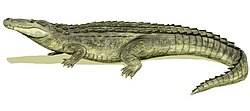| Hassiacosuchus Temporal range: Eocene, | |
|---|---|
 | |
| Fossil, State Museum of Natural History Karlsruhe | |
| Scientific classification | |
| Kingdom: | Animalia |
| Phylum: | Chordata |
| Class: | Reptilia |
| Clade: | Archosauria |
| Order: | Crocodilia |
| Superfamily: | Alligatoroidea |
| Family: | Alligatoridae |
| Subfamily: | Alligatorinae |
| Genus: | † Hassiacosuchus Weitzel, 1935 |
| Type species | |
| †Hassiacosuchus haupti Weitzel, 1935 | |
Hassiacosuchus is an extinct genus of small alligatorid from the early Eocene of Germany, found at the Messel pit. It was named in 1935 by K. Weitzel, and the type species is H. haupti. [2] A second species, H. kayi, was named in 1941 by C.C. Mook for material from the Bridgerian (early Eocene) of Wyoming, [3] but was reassigned to Procaimanoidea in 1967 by Wassersug and Hecht, who also argued that Hassiacosuchus is synonymous with Allognathosuchus. [4] Phylogenetic analyses exclude H. haupti from Allognathosuchus. [5] [1]

The cladogram below from the 2020 Cossette & Brochu study shows the placement of Hassiacosuchus within Alligatoridae: [6]
| Alligatoroidea |
| |||||||||||||||||||||||||||||||||||||||||||||||||||||||||
| (stem-based group) |


